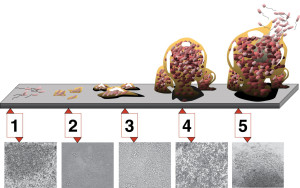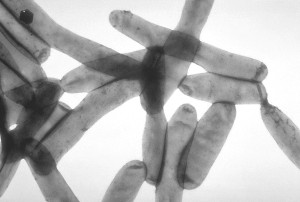A bacterium harbouring slime found on wet surfaces
by Sally Bouorm | February 1, 2014 2:54 pm
 [1]
[1]By Connie Sue Centrella
The annual World Aquatic Health Conference [2](WAHC) brings together a variety of new science-based ideas and technologies. Those who attend the symposia always leave with new found concepts and sciences to improve their knowledge. This past conference, held in Indianapolis, Ind., in October, James Amburgey[3], PhD, with the University of North Carolina at Charlotte presented findings from the fifth International Conference on Swimming Pool & Spa (ICSPS), held in early 2013 at the University of Rome. His discussion peaked a lot of people’s interest with regards to a shift in microbial focus internationally—that is, away from just traditional recreational water illnesses [4](RWIs). While Cryptosporidium, Giardia, and Escherichia coli O157:H7 (E-coli) (fecal-related illnesses) continue to be serious health issues and incidences are on the rise, a new spotlight is now on Pseudomonas aeruginosa (P. aeruginosa) and Legionella pneumophila (L. pneumophila).
 [5]
[5]These bacterium are harboured in biofilm and are not associated with fecal accidents. Common biofilm can be found growing on the surfaces of pool and hot tub filters, as well as inflatable toys, tubes, pool vacuums, and robotic cleaners, which are stored wet without any disinfection.
These micro-organisms are resistant to standard disinfection processes because the biofilm actually protects the micro-organisms from being destroyed. Biofilm is a collection of microbes living together on a wet surface. Extracellular polysaccharide substance (EPS) is the slimy goo which encases the organisms and anchors them to a surface. If there is a wet surface, there is the potential for biofilm [6](see figure 1).
Pseudomonas aeruginosa
 [7]
[7]Transmission of RWIs can occur through ingestion (drinking contaminated water), dermal (through the skin), or breathing in mists or vapours. P. aeruginosa is a common bacterium which grows in warm water and is capable of causing skin rashes. Although it is often referred to as ‘hot tub rash,’ it can also be found on people who use swimming pools. These rashes range from small itchy red bumps to larger blisters like poison ivy. Some of the risk factors include: the length of time in contact with the bacterium; the type of swimsuit; exceeding the maximum bather load; and individual tolerances to the bacterium.
There is evidence the concentration of disinfectant affects its growth. Damp areas such as decks, benches, and drains also provide growth conditions. Maintaining normal disinfection levels (1 parts per million [ppm] to 5 ppm of chlorine) has proven to curb the growth of P. aeruginosa. If the concentration falls below the ideal ranges, evidence proves these bacteria can spread.
Legionella pneumophila
 [8]
[8] [9]
[9]In addition to this rash, pathogens may be released from the biofilm into the air causing respiratory diseases like L. pneumophila. Legionellosis (Legionnaires’ disease) is found naturally in warm water environments; therefore, it can be established (trapped) in biofilm. Poor operation and inadequate chemical maintenance contribute to the growth of L. pneumophila. If this pathogen is inhaled in or near the pool or hot tub water surface, or through misters, the effects can be quite serious, sometimes causing death. Symptoms of this disease are high fever, chills, and a cough. People with weak immune systems may be predisposed to this disease.
Outbreaks have been linked to poorly maintained hot tubs and spray/mist features such as interactive water features and fountains. In 2012, the National Swimming Pool Foundation [10](NSPF) issued a strong warning regarding various indicators that legionellosis outbreaks are possible. They include:
- History of inadequate disinfectant: If the disinfectant level is not maintained any bacteria that are introduced into the system will begin to grow very rapidly and form excessive amounts of biofilm. Once biofilm forms it provides a habitat for L. pneumophila, which may be introduced with the next addition of makeup water. Hot tubs that lack automated testing and feed systems are particularly vulnerable.
- Slime: Hot tubs are not supposed to have any detectable amount of slime. Nearly every continuously moist surface develops some biofilm. In well managed systems, the amount of biofilm is limited and should not be readily detectable during a routine operational examination. Slime in hot tubs is quite often biofilm.
- Excessive and persistent foam: This usually indicates a high level of organics in the water. The organics reduce disinfectant efficacy and may also provide nutrients for the bacteria.
- Musty odours: These are most often associated with fungal growth, not L. pneumophila, but the odour still indicates high levels of microbes are growing.
- Inability to maintain sanitizer level due to high organic buildup: High organic levels make maintaining the disinfectant difficult.
- Cloudy or off-coloured water.
- Strong halogen smell—high level of halogenated disinfection byproducts: Excessive chlorine-type smells indicate a high level of halogenated disinfection byproducts. These are undesirable and indicate the water needs to be oxidized or replaced.
- Patron complaints: This should never be the first indication of an issue. When complaints are noted they must be addressed promptly and thoroughly.
Elimination of biofilm
 [11]
[11]Conventional methods of microbial control have proven inadequate when associated with biofilm. The most effective way to combat biofilm is to perform regular, preventative maintenance. The goal is not to allow biofilm to form because it is much harder to kill the organisms once they are established under the biofilm coating. Maintaining optimal sanitizer residual is critical at all times. The ideal range for chlorine disinfection is 3 to 5 ppm. This residual should be monitored regularly via manual testing (public pools should be tested at least three times per day). Further, installation of an automatic continuous-chemical-feed system, with constant monitoring, will allow for a chemical control analyzing system. In addition, daily brushing of the tile, walls, and floors should also be performed. Since pool surfaces are a common place for biofilm to attach, brushing will release the biofilm from pool surfaces where the disinfection can kill the bacteria.
Operators must also perform a thorough cleaning of the filtration system as biofilm can grow in the sand and filter laterals. Insufficient backwashing of sand filters have been found to promote the growth of biofilm. Backwashing sand filters on a regular basis are necessary; when the pressure gauge increases 0.055 to 0.068 MPa (8 to 10 pounds per square inch [psi]), it is time to backwash the filter. Be sure to backwash sufficiently until the waste water runs clear in the site glass. There are some treatment products now available that can be used to clean the biofilm. These are usually required in high bather load environments. These products are effective, but take a qualified operator to use them efficiently. It may require removal of the sand after the treatment.
For cartridge and diatomaceous earth (DE) filters, be sure to clean the fibres properly by degreasing the media prior to any acid washing. Some operators also soak the cartridges and grids in chlorinated water prior to placing them back into the filter vessel.
Another recommendation is to raise the chlorine level to 10 ppm in hot tubs on a weekly basis or after high bather load incidences and circulate the high chlorine residual for at least one hour. In any case, be aware of evidence of biofilm growth if pools and hot tubs are not maintained efficiently.
Residential pool issues
While the focus of this article may lead to the perception there is no issue in the residential pool market, this is incorrect. Numerous studies have shown all hot water environments to promote biofilm growth, thus leading to P. aeruginosa, ‘hot tub rash,’ and L. pneumophila. Therefore, without proper care, every ‘self-contained’ (portable) hot tub is susceptible to biofilm growth and bacterial infections. In fact, the bubbling action created by blowers and air jets, which bring mists and vapours to the surface, enhance the potential for L. pneumophila. All pool/hot tub dealers and service professionals in the residential market should be sure to provide their clients with specific instructions on proper maintenance and water chemical treatments. For example, maintaining a chlorine or bromine residual at all times, removing the cover periodically to ‘let the hot tub breathe,’ and cleaning the filter and housing is recommended.
The responsibility of pool and hot tub professionals is to provide all owners with an understanding of the effects of biofilm and conditions such as P. aeruginosa and L. pneumophila. The bathing public should be informed of the risks involved whereby offering them the most recent studies to ensure a safe and healthy bather experience. This can be done without imposing fear; rather, by sharing proper education on the use and care of their pool and hot tub environment for years of healthy enjoyment.
 Connie Gibson Centrella, MBA, is a professor and program director for the online Aquatic Engineering Degree Program at Keiser University eCampus. She is also the director of education for Team Horner as well as a sustainability officer, having been certified in the principles of ‘green’ and sustainable business practices. Centrella, an industry veteran with more than 40 years of experience in the aquatics field, is a five-time recipient of the Evelyn C. Keiser Teaching Excellence Award ‘Instructor of Distinction.’ She is also a former pool builder with extensive knowledge in pool construction, equipment installation and manufacturing, and a National Swimming Pool Foundation (NSPF) certified pool/spa operator instructor, having trained more than 1,850 pool service technicians, retailers and instructors worldwide in the past 10 years.
Connie Gibson Centrella, MBA, is a professor and program director for the online Aquatic Engineering Degree Program at Keiser University eCampus. She is also the director of education for Team Horner as well as a sustainability officer, having been certified in the principles of ‘green’ and sustainable business practices. Centrella, an industry veteran with more than 40 years of experience in the aquatics field, is a five-time recipient of the Evelyn C. Keiser Teaching Excellence Award ‘Instructor of Distinction.’ She is also a former pool builder with extensive knowledge in pool construction, equipment installation and manufacturing, and a National Swimming Pool Foundation (NSPF) certified pool/spa operator instructor, having trained more than 1,850 pool service technicians, retailers and instructors worldwide in the past 10 years.
- [Image]: http://poolspamarketing.com/wp-content/uploads/2014/02/bigstock-Inflatable20922FD.jpg
- World Aquatic Health Conference : http://www.thewahc.org
- James Amburgey: https://cee.uncc.edu/directory/james-e-amburgey-phd
- recreational water illnesses : http://www.cdc.gov/healthwater/swimming/rwi
- [Image]: http://www.poolspas.ca/wp-content/uploads/2015/05/Biofilm.jpg
- biofilm : http://www.plosbiology.org/article/info%3Adoi%2F10.1371%2Fjournal.pbio.0050307#s2
- [Image]: http://www.poolspas.ca/wp-content/uploads/2015/05/Pseudomonas_Aeruginosa-1.jpg
- [Image]: http://www.poolspas.ca/wp-content/uploads/2015/05/bigstock-Top-View-Happy-People-Relax-9881759-2.jpg
- [Image]: http://www.poolspas.ca/wp-content/uploads/2015/05/Legionella_pneumophila_01.jpg
- National Swimming Pool Foundation : http://www.nspf.com
- [Image]: http://www.poolspas.ca/wp-content/uploads/2015/05/bigstock-Night-Hot-Tub-1738502_edited-1.jpg
Source URL: https://www.poolspamarketing.com/trade/a-bacterium-harbouring-slime-found-on-wet-surfaces/